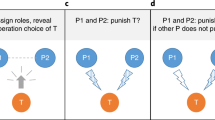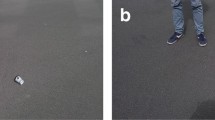Abstract
Economists conducting laboratory experiments on cooperation and peer punishment find that a non-negligible minority of punishments is directed at cooperators rather than free riders. Such punishments have been categorized as ‘perverse’ or ‘antisocial,’ using definitions that partially overlap, but not entirely so. Which approach better identifies punishment that discourages cooperation? We analyze the data from 16 sites studied by Herrmann et al. (Science 319(5868):1362–1367, 2008) and find that when subjects are uninformed about who punished them, the recipient’s contribution relative to the group average (whether it is ‘perverse’) is a better predictor of negative impact on contribution than is her contribution relative to the punisher’s (whether it is ‘antisocial’). Regression estimates nevertheless suggest that punished subjects attempt to take relative contribution of punisher into account even if only by conjecture.
Similar content being viewed by others
Notes
In their survey of the literature, Gächter and Herrmann (2008) acknowledge the difference between the “antisocial” and “perverse” terms, and the two groups of researchers have acknowledged one another’s work, treating their approaches as alternative ways to analyze a shared concern. Our paper is in no sense meant as a criticism of Herrmann et al. (2008), a paper we see as making an outstanding contribution to the comparative experimental study of cooperative norms.
In Part 1 of our Online Appendix, we investigate whether Herrmann et al. (2008) would have obtained qualitatively similar results had they focused on the perverse/normal distinction rather than the antisocial/prosocial one, when analyzing the differences between sites in their study. Although our analysis there is not exhaustive, it supports the idea that their findings would not have changed dramatically.
See, e.g., Nikiforakis (2008), pp. 102–103. In private communication, Nikos Nikiforakis states that in this discussion, “I was using the term “antisocial punishment” to refer to what you call “perverse punishment”. I thought this made a natural contrast to what was often called “prosocial” punishment.”
As a simple example, suppose that the endowment is 20, group size is 4, and contributions are Ci= 4, Cj = 8, Ck = 12 and Cl = 16, respectively. If i or j punish k or l, those actions are both perverse and antisocial, and if k or l punish i or j, those actions are both normal and prosocial. However, i punishing j is normal but antisocial, and l punishing k is perverse but prosocial.
We assign countries to groups according to the positions of the bars representing them in Herrmann et al.’s (2008) Figure 1, which sorts sites in order of their mean amounts of antisocial punishment. Different groupings result from using other criteria, such as the proportion of total punishment that is antisocial, or the proportion of total punishment that is perverse, but there is considerable overlap, as shown by Figures A.1 and A.2 of the Online Appendix.
62.08% of expenditure on punishments in Athens and 52.26% in Muscat are antisocial. 53.07% of expenditure on punishment in Muscat is perverse.
Returning to the example in which a group of four has contributions 4, 8, 12 and 16, only punishment given to the contributors of 12 or 16 can be perverse, but punishment given by the contributor of 4 to that of 8 is also antisocial. Still, differences in opportunity also run in the reverse direction: when the contributor of 16 punishes the contributor of 12, it counts as a perverse but not as an antisocial punishment event. If contribution patterns were typically as symmetrical as this one, the greater shares of antisocial than of perverse punishment would imply that i types (who contribute about 4) punish j types (who contribute 8) more often than l types (who contribute about 16) punish k types (who contribute 12). Contribution patterns need not always be so symmetrical, however, so the opportunity to punish antisocially but normally can also be more frequent than the opportunity to punish prosocially but perversely.
The fourth row of each table segment also shows that of the four cross-classifications, opportunities to punish that are both perverse and antisocial are least likely to be made use of, with only 5.2% of those opportunities seeing actual punishment in the less antisocial sites and 17.4% in the more antisocial sites. Even in the latter sites, few subjects appear inclined to punish group members who contribute both more than the average and more than they themselves do. This is the case despite the fact that the configuration of contributions in given groups and periods made opportunities to perversely and antisocially punish more than twice as common (61.5% of all potential cases) as opportunities to punish normally and prosocially (25.3%), a frequency difference that is significant at the 0.1% level according to a two-tailed Pearson’s chi-squared test.
See Part 2 of the Online Appendix for details.
Separate estimates for the data of each of Herrmann et al.’s 16 sites are shown in Tables A.1 and A.2 of the Online Appendix.
Model (6) is also preferred to model (3) according to both the Akaike Information Criterion and the Bayesian Information Criterion, although differences in scores are small: the AIC measure for (6) is 57137.5 and for (3) it is 57342.2.
To be sure, there are other ways that contribution position can be classified, and ambiguities to be addressed with the four position classification. We address those ambiguities in the same way as Page et al. (2013), namely: if there are only three contribution levels, we code the middle contribution as second if it is above or equal to the average and as third if below the average. If there are only two contribution levels, we code them as h and l. If there is only one contribution level, we code it as h if it is 20, l if 0, and otherwise we drop that period’s observations. The considerable significance attaching to many of the coefficients in Tables A.12, Table A.15 and Table A.7 suggest to us that this positional categorization approach captures much of what subjects themselves perceived and responded to.
The coefficients on the positional terms confirm a common finding in the literature of a tendency by subjects to adjust towards the group mean, even if time trends of average contribution are also present. The fact that including positional terms not interacted with amount of punishment received does not qualitatively change these coefficients is also reassuring insofar as the estimates showing a negative impact of perverse punishment on contribution in Cinyabuguma et al.’s (2006) working paper and in Önes and Putterman (2007), reported above, are obtained without including such terms.
Separate estimates for the data of each of Herrmann et al.’s (2008) 16 sites are shown in Table A.8 of the Online Appendix.
Although the impact of perverse, antisocial punishment is only marginally significant in the least antisocial subject pools, in Table 4, that coefficient is significant at the 1% level in the Tobit estimate, Table A.5.
The relevant coefficient is significant and positive, in Table 4, but is insignificant in the Tobit variant, Table A.5.
Subjects could unambiguously distinguish only four categories: (i) normal and identifiably prosocial, (ii) normal but ambiguous (as to prosocial or antisocial character), (iii) perverse and identifiably antisocial, and (iv) perverse but ambiguous, and these categories are used in the Tables A.11 and A.12 exercises. An “omniscient observer,” and the experimenter, can disaggregate category (ii) into (ii-a) normal and unidentifiably (from the subject’s standpoint) prosocial, and (ii-b) normal and unidentifiably antisocial, and likewise with (iv). The Tables A.13 and A.15 regressions look for differences in impact on contribution among these six experimenter-distinguishable categories. Tables A.14 and A.16 show corresponding Tobit estimates.
This includes our discussions of overall goodness of fit and of the estimated coefficients on perverse versus antisocial punishment in Table 3, and of the exercises in Tables A.13 and A.15.
See Tables 4, A.5, A.8, A.9, A.10, and A.13–A.16.
References
Bochet, O., Page, T., & Putterman, L. (2006). Communication and punishment in voluntary contribution experiments. Journal of Economic Behavior & Organization, 60(1), 11–26.
Carpenter, J., & Matthews, P. (2009). What norms trigger punishment? Experimental Economics, 12(3), 272–288.
Chaudhuri, A. (2011). Sustaining cooperation in laboratory public goods experiments: a selective survey of the literature. Experimental Economics, 14(1), 47–83.
Cheung, S. (2014). New insights into conditional cooperation and punishment from a strategy method experiment. Experimental Economics, 17(1), 129–153.
Cinyabuguma, M., Page, T., & Putterman, L. (2006). Can second-order punishment deter perverse punishment? Experimental Economics, 9(3), 265–279.
Ertan, A., Page, T., & Putterman, L. (2009). Who to punish? Individual decisions and majority rule in mitigating the free rider problem. European Economic Review, 53(5), 495–511.
Fehr, E., & Gächter, S. (2000). Cooperation and punishment in public goods experiments. American Economic Review, 90(4), 980–994.
Gӓchter, S., & Herrmann, B. (2008). Reciprocity, culture and human cooperation: previous insights and a new cross-cultural experiment. Philosophical Transactions of the Royal Society B, 364(1518), 791–806.
Gächter, S., & Herrmann, B. (2011). The limits of self-governance when cooperators get punishment: Experimental evidence from urban and rural Russia. European Economic Review, 55(2), 193–210.
Gächter, S., Herrmann, B., & Thöni, C. (2010). Culture and cooperation. Philosophical Transactions of the Royal Society B, 365(1553), 2651–2661.
Herrmann, B., Thöni, C., & Gächter, S. (2008). Antisocial punishment across societies. Science, 319(5868), 1362–1367.
Nikiforakis, N. (2008). Punishment and counter-punishment in public good games: Can we really govern ourselves? Journal of Public Economics, 92(1–2), 91–112.
Önes, U., & Putterman, L. (2007). The ecology of collective action: A public goods and sanctions experiment with controlled group formation. Journal of Economic Behavior & Organization, 62(4), 495–521.
Ostrom, E., Walker, J., & Gardner, R. (1992). Covenants with and without a sword: Self-governance is possible. American Political Science Review, 86(2), 404–417.
Page, T., Putterman, L., & Garcia, B. (2013). Voluntary contributions with redistribution: The effect of costly sanctions when one person’s punishment is another’s reward. Journal of Economic Behavior & Organization, 95, 34–48.
Thöni, C. (2014). Inequality aversion and antisocial punishment. Theory and Decision, 76(4), 529–545.
Acknowledgements
We are grateful to Christian Thöni for sharing with us the data of Herrmann et al. (2008). We thank the editor, Nikos Nikoforakis, two anonymous reviewers, and Kenju Kamei for helpful comments and suggestions. We thank Brown University for hosting the visit by Tingting Fu during the 2015–2016 academic year.
Author information
Authors and Affiliations
Corresponding author
Electronic supplementary material
Below is the link to the electronic supplementary material.
Rights and permissions
About this article
Cite this article
Fu, T., Putterman, L. When is punishment harmful to cooperation? A note on antisocial and perverse punishment. J Econ Sci Assoc 4, 151–164 (2018). https://doi.org/10.1007/s40881-018-0053-6
Received:
Revised:
Accepted:
Published:
Issue Date:
DOI: https://doi.org/10.1007/s40881-018-0053-6




